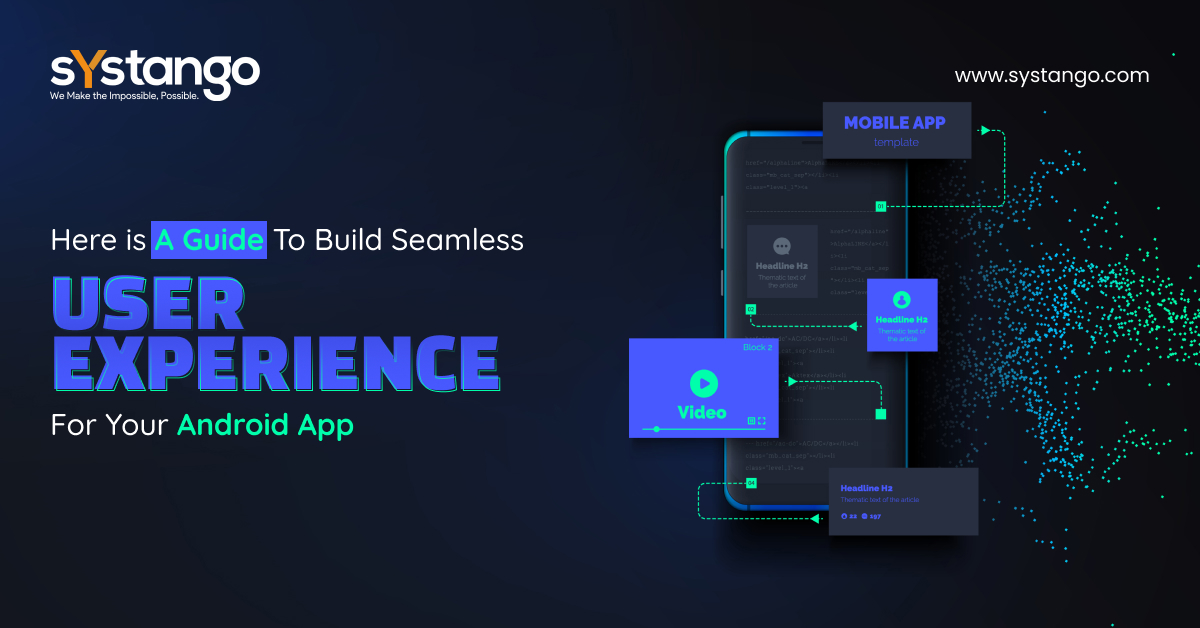7 Essential Android Settings to Unlock a Seamless Experience
Related Articles: 7 Essential Android Settings to Unlock a Seamless Experience
- Ultimate 7 Android Battery Saving Tips: Unlocking Unstoppable Power
- 5 Powerful Ways To Unleash Your Android Phone’s Speed Demon
- Unleash The Power! 10 Awesome Hidden Android Features You Need To Know
Introduction
In this auspicious occasion, we are delighted to delve into the intriguing topic related to 7 Essential Android Settings to Unlock a Seamless Experience. Let’s weave interesting information and offer fresh perspectives to the readers.
Table of Content
7 Essential Android Settings to Unlock a Seamless Experience

Android’s open-source nature offers a level of customization that’s unmatched by other mobile operating systems. While this flexibility can be overwhelming for new users, it also presents an opportunity to personalize your device and unlock a truly seamless experience. This article will guide you through seven essential Android settings that you should adjust to optimize your phone for your unique needs and preferences.
1. Notifications: The Silent Symphony of Your Digital Life
Android’s notification system can be a blessing or a curse. It’s essential to tame the barrage of alerts and create a notification ecosystem that works for you. Here’s how to take control:
- Prioritize Apps: Not all notifications are created equal. Use the "Priority" setting in the "Notifications" section of your Android settings. This allows you to categorize apps based on their importance. For instance, messages from your loved ones or urgent alerts from work should be prioritized, while notifications from social media apps can be relegated to lower priority.
- Customize Notification Sounds: Each app’s notification sound can be customized to your liking. This allows you to instantly recognize the source of a notification without even looking at your phone. Use distinct tones for important apps and softer sounds for less critical ones.
- Silence Notifications: Sometimes, even prioritized notifications can become disruptive. You can silence notifications for specific periods, like during a meeting or while sleeping. Use "Do Not Disturb" mode for complete peace or customize specific timeframes for individual apps.
- Control Visual Distractions: Notifications can be visually distracting, especially when you’re trying to focus. You can adjust the appearance of notifications to minimize visual clutter. Opt for a simple notification light or disable the notification banner altogether for specific apps.
2. Gestures: Navigating with Finesse
Android’s gesture navigation system offers a seamless and intuitive way to interact with your device. It’s a game-changer for one-handed operation and eliminates the need for on-screen buttons. Here’s how to master it:
- Enable Gesture Navigation: Head to "System" and then "Gestures" in your Android settings. Enable "Gesture Navigation" and explore the different options.
- Master the Swipe: The core of gesture navigation is swiping. Swipe up from the bottom of the screen to return to the home screen. Swipe up from the bottom and hold to access the recent apps menu. Swipe in from the left or right edges of the screen to go back.
- Customize Back Gesture: You can choose to have the back gesture activate from the left, right, or both sides of the screen. Experiment to find what feels most natural for you.
- Explore Advanced Gestures: Some Android devices offer advanced gestures like double-tapping to wake the screen or swiping down from the top right corner to open the notification shade. Explore these features to streamline your interactions.

3. Display: A Visual Feast for the Senses
Your phone’s display is your window to the digital world. Customize it to enhance your visual experience and make your screen more comfortable to use:
- Adjust Brightness: Adjusting the brightness of your screen is crucial for both battery life and eye comfort. Set the brightness to an appropriate level for the lighting conditions. Consider using "Adaptive Brightness" to automatically adjust the brightness based on your environment.
- Explore Color Modes: Different color modes can drastically alter the appearance of your screen. Experiment with "Natural," "Vivid," or "Warm" modes to find the color palette that suits your preferences.
- Enable Dark Mode: Dark mode inverts the color scheme of your phone, making it easier on your eyes, especially in low-light conditions. It also reduces battery drain on OLED displays.
- Customize Display Size: Adjust the display size to suit your visual preferences and make text and icons easier to read. Smaller font sizes can be beneficial for those with excellent vision, while larger fonts can be easier on the eyes for those with visual impairments.
4. Battery: Extending Your Phone’s Life
Battery life is a constant concern for smartphone users. By understanding and optimizing your battery settings, you can extend your phone’s usage time and avoid those dreaded low-battery anxiety attacks:

- Monitor Battery Usage: Use the "Battery" section in your Android settings to see which apps are consuming the most power. Identify and manage apps that are draining your battery excessively. Consider limiting their background activity or uninstalling them altogether if they are not essential.
- Enable Battery Saver: When your battery starts getting low, activate Battery Saver mode. This feature restricts background activity and limits performance to conserve power. You can also schedule Battery Saver mode to activate automatically when your battery reaches a certain threshold.
- Optimize Power Settings: Reduce the brightness of your screen, disable Wi-Fi and Bluetooth when not in use, and limit background data usage for apps that don’t require constant connectivity. These small tweaks can significantly impact your battery life.
- Use Adaptive Battery: This feature learns your usage patterns and prioritizes the apps you use most frequently. It intelligently manages background activity to ensure that the apps you need are always ready to go, while limiting the power consumption of less-used apps.
5. Storage: Keep Your Phone Spick and Span
With the ever-increasing amount of data we store on our phones, storage management becomes crucial. Here’s how to keep your phone running smoothly:
- Monitor Storage Usage: Use the "Storage" section in your Android settings to see what’s taking up space on your device. Identify large files, unnecessary apps, and cache data that can be safely deleted.
- Clear Cache Data: Apps store temporary data in their cache, which can accumulate over time. Clearing cache data for individual apps can free up significant storage space without affecting app functionality.
- Move Apps to SD Card: If your device supports expandable storage, you can move apps and data to an SD card to free up internal storage space. This can be particularly useful for apps that require large amounts of data, such as games.
- Use Cloud Storage: Utilize cloud storage services like Google Drive, Dropbox, or OneDrive to store photos, documents, and other files online. This frees up valuable internal storage space and allows you to access your files from any device.
6. Privacy: Protecting Your Digital Footprint
In today’s data-driven world, privacy is paramount. Android provides a robust set of tools to control how your personal information is collected and used:
- Manage App Permissions: Use the "Permissions" section in your Android settings to control which apps have access to your location, camera, microphone, contacts, and other sensitive data. Grant permissions only to apps that genuinely require them.
- Use a VPN: A Virtual Private Network (VPN) encrypts your internet traffic and masks your IP address, making it harder for websites and advertisers to track your online activity.
- Enable Location History: You can disable location history to prevent Google from tracking your movements. This can be particularly important if you’re concerned about privacy.
- Use a Privacy-Focused Browser: Consider using a privacy-focused browser like Firefox Focus or Brave, which block trackers and minimize the collection of your browsing data.
7. Security: Building a Digital Fortress
Protecting your phone from unauthorized access is crucial. Android provides multiple layers of security to safeguard your data:
- Set a Strong Password: Use a strong password or passcode to lock your phone’s screen. Avoid using common or easily guessable passwords.
- Enable Biometric Authentication: Use fingerprint or facial recognition to unlock your phone for added security. These methods are more convenient and secure than traditional passwords.
- Enable Find My Device: This feature allows you to locate your lost or stolen phone, remotely lock it, or erase its data. Ensure that Find My Device is enabled and that your Google account is linked to your device.
- Use a Security App: Consider installing a security app that provides additional features like anti-theft protection, malware detection, and data encryption.
Conclusion: A Personalized Android Experience
By mastering these essential Android settings, you can unlock a truly personalized and seamless experience. From customizing notifications and gestures to optimizing battery life and safeguarding your privacy, these settings empower you to take control of your digital life. Don’t be afraid to experiment and find the settings that best suit your individual needs and preferences. Your Android phone is a powerful tool, and with a little customization, it can become your perfect digital companion.
Closure
Thus, we hope this article has provided valuable insights into 7 Essential Android Settings to Unlock a Seamless Experience. We appreciate your attention to our article. See you in our next article!
google.com




